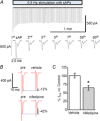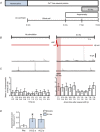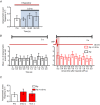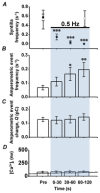Catecholamine exocytosis during low frequency stimulation in mouse adrenal chromaffin cells is primarily asynchronous and controlled by the novel mechanism of Ca2+ syntilla suppression
- PMID: 25128575
- PMCID: PMC4253468
- DOI: 10.1113/jphysiol.2014.278127
Catecholamine exocytosis during low frequency stimulation in mouse adrenal chromaffin cells is primarily asynchronous and controlled by the novel mechanism of Ca2+ syntilla suppression
Abstract
Adrenal chromaffin cells (ACCs), stimulated by the splanchnic nerve, generate action potentials (APs) at a frequency near 0.5 Hz in the resting physiological state, at times described as 'rest and digest'. How such low frequency stimulation in turn elicits sufficient catecholamine exocytosis to set basal sympathetic tone is not readily explained by the classical mechanism of stimulus-secretion coupling, where exocytosis is synchronized to AP-induced Ca(2+) influx. By using simulated action potentials (sAPs) at 0.5 Hz in isolated patch-clamped mouse ACCs, we show here that less than 10% of all catecholaminergic exocytosis, measured by carbon fibre amperometry, is synchronized to an AP. The asynchronous phase, the dominant phase, of exocytosis does not require Ca(2+) influx. Furthermore, increased asynchronous exocytosis is accompanied by an AP-dependent decrease in frequency of Ca(2+) syntillas (i.e. transient, focal Ca(2+) release from internal stores) and is ryanodine sensitive. We propose a mechanism of disinhibition, wherein APs suppress Ca(2+) syntillas, which themselves inhibit exocytosis as they do in the case of spontaneous catecholaminergic exocytosis.
© 2014 The Authors. The Journal of Physiology © 2014 The Physiological Society.
Figures









Similar articles
-
Enhanced Ca(2+)-induced Ca(2+) release from intracellular stores contributes to catecholamine hypersecretion in adrenal chromaffin cells from spontaneously hypertensive rats.Pflugers Arch. 2015 Nov;467(11):2307-23. doi: 10.1007/s00424-015-1702-8. Epub 2015 Mar 21. Pflugers Arch. 2015. PMID: 25791627
-
Suppression of Ca2+ syntillas increases spontaneous exocytosis in mouse adrenal chromaffin cells.J Gen Physiol. 2009 Oct;134(4):267-80. doi: 10.1085/jgp.200910285. J Gen Physiol. 2009. PMID: 19786582 Free PMC article.
-
Syntillas release Ca2+ at a site different from the microdomain where exocytosis occurs in mouse chromaffin cells.Biophys J. 2006 Mar 15;90(6):2027-37. doi: 10.1529/biophysj.105.071654. Epub 2005 Dec 30. Biophys J. 2006. PMID: 16387759 Free PMC article.
-
Calcium signaling and exocytosis in adrenal chromaffin cells.Physiol Rev. 2006 Oct;86(4):1093-131. doi: 10.1152/physrev.00039.2005. Physiol Rev. 2006. PMID: 17015485 Review.
-
CaV1.3 as pacemaker channels in adrenal chromaffin cells: specific role on exo- and endocytosis?Channels (Austin). 2010 Nov-Dec;4(6):440-6. doi: 10.4161/chan.4.6.12866. Epub 2010 Nov 1. Channels (Austin). 2010. PMID: 21084859 Review.
Cited by
-
Sustained Exocytosis after Action Potential-Like Stimulation at Low Frequencies in Mouse Chromaffin Cells Depends on a Dynamin-Dependent Fast Endocytotic Process.Front Cell Neurosci. 2016 Jul 26;10:184. doi: 10.3389/fncel.2016.00184. eCollection 2016. Front Cell Neurosci. 2016. PMID: 27507935 Free PMC article.
-
Nanoelectrochemistry reveals how presynaptic neurons regulate vesicle release to sustain synaptic plasticity under repetitive stimuli.Chem Sci. 2024 Apr 15;15(20):7651-7658. doi: 10.1039/d4sc01664e. eCollection 2024 May 22. Chem Sci. 2024. PMID: 38784745 Free PMC article.
-
How does the stimulus define exocytosis in adrenal chromaffin cells?Pflugers Arch. 2018 Jan;470(1):155-167. doi: 10.1007/s00424-017-2052-5. Epub 2017 Aug 29. Pflugers Arch. 2018. PMID: 28852855 Review.
-
Enhanced Ca(2+)-induced Ca(2+) release from intracellular stores contributes to catecholamine hypersecretion in adrenal chromaffin cells from spontaneously hypertensive rats.Pflugers Arch. 2015 Nov;467(11):2307-23. doi: 10.1007/s00424-015-1702-8. Epub 2015 Mar 21. Pflugers Arch. 2015. PMID: 25791627
References
-
- Becker PL. Fay FS. Photobleaching of fura-2 and its effect on determination of calcium concentrations. Am J Physiol. 1987;253:C613–618. - PubMed
-
- Cannell MB, Cheng H. Lederer WJ. The control of calcium release in heart muscle. Science. 1995;268:1045–1049. - PubMed
-
- Cheng H, Lederer WJ. Cannell MB. Calcium sparks: elementary events underlying excitation–contraction coupling in heart muscle. Science. 1993;262:740–744. - PubMed
Publication types
MeSH terms
Substances
Grants and funding
LinkOut - more resources
Full Text Sources
Other Literature Sources
Miscellaneous

